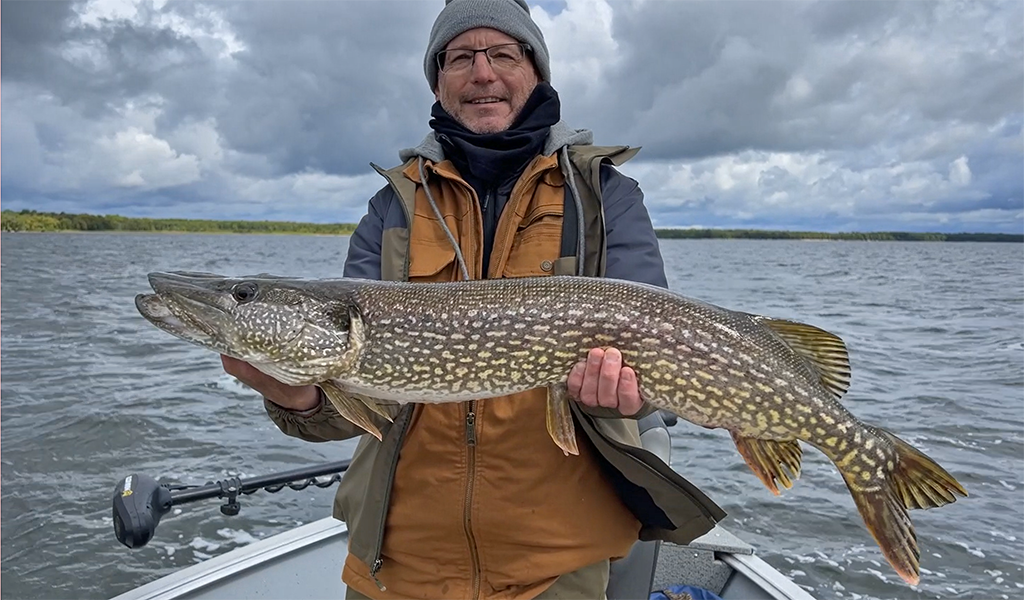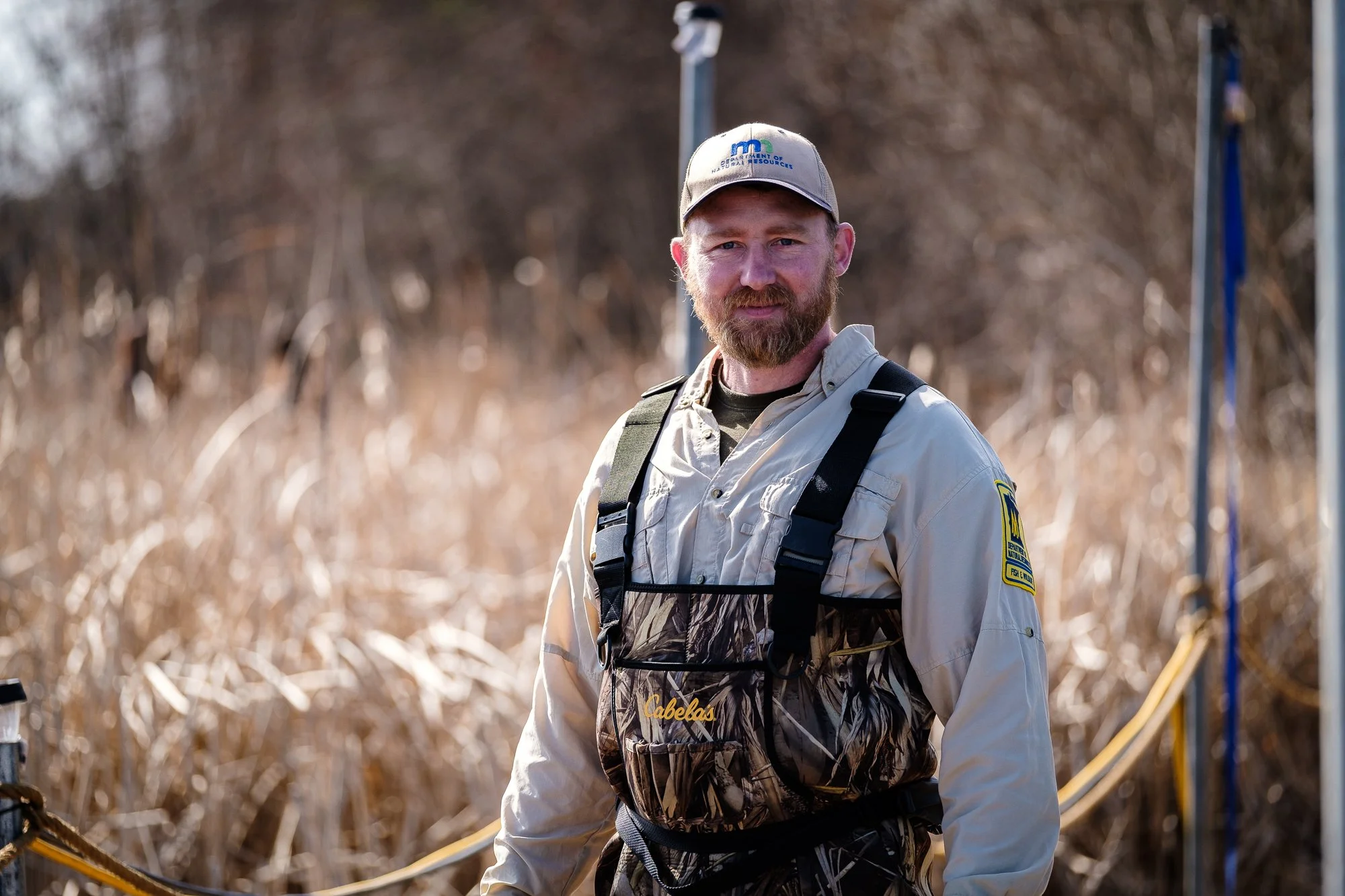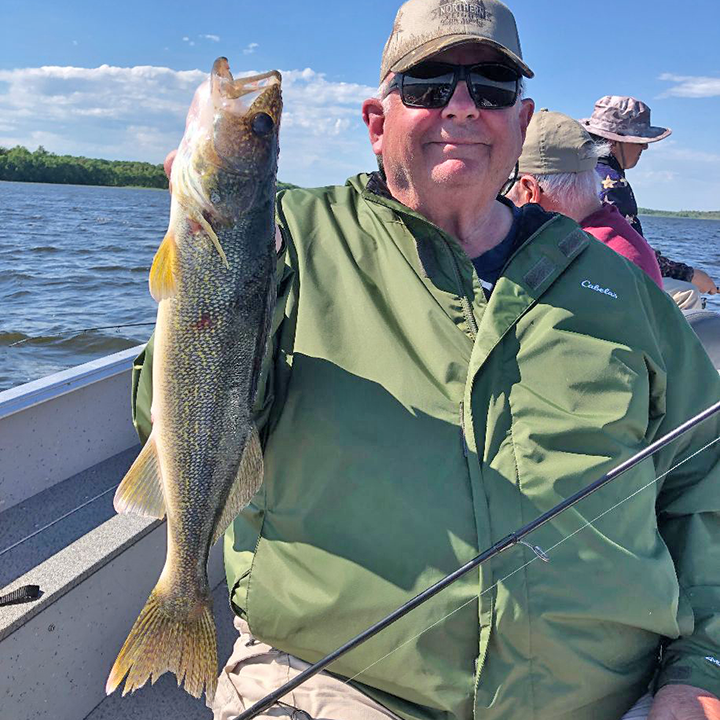Fishing guide Jeff Sundin shares his thoughts and tactics ahead of Minnesota’s fishing opener on May 11th, 2024
Meet Dan Schermerhorn, Lake Winnie's New DNR Large Lake Specialist
Season In Transition Lake Winnie Cutfoot Sioux Report July 8, 2021
Mid-Summer fishing patterns have developed on both Winnie and Cutfoot. With rising water temperatures, fish are more prone to strike faster moving lures, so finesse techniques for walleyes are out, and aggressive, trolling and casting presentations are in.
Panfish, perch and pike, as many of our guests are learning, actually come along as a by-product of trolling for walleye. The species that we catch depends on which area of the lake we’re fishing. Head out onto the big lake and troll the flats with bottom bouncers and the mix will be pike, perch, and walleye.
Move into Cutfoot and begin trolling the weed edges with spinners and the mix will broaden, sunfish, crappie, rock bass and even an occasional largemouth will find your offering.
Trolling, as popular as it is, isn’t the only aggressive fishing style that will trigger fish to strike during mid-summer. Gaining fast in popularity are cast-and-retrieve presentations, here’s why.
With the arrival of clear water caused by Zebra Mussels, fish, especially walleyes have become more “boat shy” than they used to be. They can still be caught, but sometimes driving the boat over them will force them to move before an anglers lure can get in front of them. Positioning your boat within casting distance, but not directly overhead will allow you to present a lure to the fish before they are alerted to your presence and therefore less prone to strike.
Locating structure is the key, cabbage patches, rock piles and sharp, well-defined points make good targets. Remember, you want your lure to arrive in front of the fish before your boat does. Unless you have the latest and greatest side-imaging technology and really know how to use it, casting toward likely structure is your best chance of finding fish. Even if it takes a few tries, have faith in finding good structure and your effort will eventually be rewarded.
Casting heavy, fast moving lures like jigging raps is one casting presentations that works, sometimes. When they work, they work great, but walleyes don’t always respond to the super- high retrieval speed that these lures require. Another more moderate casting presentation is to use jigs tipped with plastic, action style tails. Paddle tails, shad imitating lures and even large twister tails can all work. This group of lures not only allows anglers to cast good distances away from the boat, but also have an enticing action as they drop into the water column. The longer “hang-time” gives fish an extra few seconds to respond and will often produce strikes when heavy jigging lures are too much.
If you’ve never tried casting jigs with plastics, a good starting off point is to pair a round head 1/8 ounce Lindy Jig with a 3 inch Ripple Shad. Cast the lure towards the fish, let it fall and then begin your retrieve using a sweep-drop-sweep-drop motion. Remember, lures like these offer attracting power moving either up or down; be sure to offer fish plenty of drop-time.
Casting jigs and plastics will allow you to drum up some panfish action in Cutfoot right now too. Scale the lures down in size, 1/16 ounce jigs tipped with 2 inch tails will fit the bill size-wise. Everything that swims in the lake will strike these lures, so have fun experimenting.
Crappies have been stubborn during the day, but can be found during early morning and late evening. Sunfish, because of the warm weather have been more cooperative during the day, but they too show a preference for moving between late afternoon and dusk.
Perch are where we find them these days, weeds are sometimes good, rocks are good at times too and even deep mud-sand transitions hold schools of them. Trolling spinners is probably the best way to locate fish. Once you have an idea where they are, narrow down your territory and rig up with jigs, or Lindy Rigs and focus on the more tightly grouped schools of fish. When our guests find them, they catch some good size fish, average size ranges from 9-1/2 to 11 inches this summer.
Northern pike, particularly larger ones are still roaming deep water. Fishing steep structure on the lakes larger bars using live bait is probably the best way to target them. Creek chubs, large suckers or big golden shiners will all work; Lindy Rigging or slip-floats are the 2 best presentations to try. Trolling crankbaits on top of the flats is an alternative for pike as well, focus on water depths of 14 to 16 feet and troll at brisk speeds, 2.5 to 3.0 MPH. Rattle baits, shad raps, reef runners, use your imagination about which lures to try. Crawdad patterns, Firetiger, bright orange and white are all food colors, tailor your color selection to the water conditions. On rocks, crawfish patterns are great, in open water, maybe white would be better; experiment until you get the desired results.
With the Independence Day holiday behind us, we are already beginning to look forward to early fall fishing patterns. But first, there are a lot of cookouts, swimming, and water sports on the agenda. Take advantage of the great weather while you can and if you’re in the area, stop in for a chat!
Lake Winnibigoshish and Cutfoot Sioux Fishing Report: Summer Trends Starting in June
Bowen Lodge Winnibigoshish - Cutfoot Sioux Fishing Report May 26, 2021
After a weeklong warm up, a slightly cold, cold front interrupted progress toward early summer walleye patterns on Sunday. Walleyes that had already moved onto deep water structure stayed where they were, but there was not much change in numbers. According to incoming reports, small, scattered packs of larger, mostly female fish were all that could be turned up out there.
Surface water temperatures rebounded nicely afterward, hitting the 65-degree mark on Monday. Walleyes resumed their migration, in fact picked up their pace, we believe. By late in the day, larger schools of smaller male fish started showing up on some of the prominent bars and deep-water points. This is good news, because these migrating fish have been found in water depths of 15 to 22 feet.
Until now, many have relied on the most popular destinations for walleye action, the steep, shoreline breaks adjacent to the Mississippi River Channel. Because those fish have been holding in deeper water, 26 to 32 feet. Catching them with the expectation that they can be released unharmed, is not realistic and certainly not an ideal scenario for nurturing the maturing population of 2018 and 2019-year classes.
Warming water has helped in other ways too, insect hatches have started up and algae blooms are giving the lake a little extra color.
There’s nothing better for starting up a mid-lake “structure bite” than a good bug hatch! Larvae, developing over the lakes soft-bottom flats, attract minnows and small fish. Those baitfish in turn, attract larger predator fish and before you know it, there is an entire food chain set up around the lakes numerous bars and humps.
Focus primarily on fish using the upper edges of the structure. They are both easier to catch and easier to release. Easier to catch because aggressive, feeding fish typically move shallow to do so. Fish that you mark on your electronics in deeper water are more likely to be negative or neutral at best. And if they can be caught, releasing them safely is more difficult than it is to release fish caught in shallower water.
Algae blooms are critical in many ways, not the least of which is that they help darken Lake Winnie’s clear water.
One thing we learned in 2020 was that when the lake’s water darkened thanks to heavy algae blooms, fish behavior changed for the better. As if somebody flipped on a light switch, walleyes moved into “pre-Zebra Mussel”, shallow water haunts that were popular with Bowen Lodge guests 20, 30 and 40 years ago. Fishing shallow water bars, weed patches and the popular 8 to 10 shoreline sand breaks was as good as it ever was.
While the water is still much clearer than it was last summer, we have noticed this week, that certain areas of the lake do show signs of increasing algae blooms. We’re hoping for a nice long stretch of warm weather to help intensify both algae blooms and insect hatches. Which brings us to the last point about both, walleye growth rates.
Winnie is already known for having growth rates that are well above average when compared to other lakes in the region. Algae is food (zooplankton) and the more of it there is in the water, the faster young fish grow. That faster growth rate is what we’re looking forward to more than ever this season. Soon, walleyes from the 2018-year class will begin crossing the 14-to-15-inch mark and that will be a fabulous development for visitors to the lake.
Planning a Memorial Weekend walleye fishing trip to Winnie won’t be difficult because fishing patterns remain simple.
The jig and minnow bite is still very reliable. Set up your 6 to 7 foot, light or medium-light fishing rods with 6 pound test line, 8 pound test at the heaviest. Pack a variety of jigs in the 1-8-to-1–4-ounce range. Shiners are widely available right now and they do work well, so if you like them, then use shiners. But, if you can find large fatheads or rainbows, they will perform equally well for walleyes.
Lindy Rigs are producing fish for folks too, so bringing an array of walking sinkers in the ¼ to ½ ounce size range, along with a few packs of Lindy Rigs, some in the #6 leech and night crawler size, some in the #4 or #2 minnow size will get you started.
Leeches and night crawlers have begun working on mid-lake structure but using larger than average minnows is still by far the best Lindy Rigging bait. This is especially true whenever the bite is “off”, negative, and neutral can watch your fast-moving jig and minnow slip by without flinching. But these fish have a much harder time snubbing a lively minnow moving s-l-o-w-l-y past their noses. So, if you’re at the bait shop and spot large shiners or rainbows, pick up a few, they might come in handy.
Perch are where you find them right now, most of them are being caught as a byproduct of walleye fishing. We have noticed that many of the larger perch are caught in areas where insect hatches are occurring. The relationship between perch and bloodworms is well-known. So, if you’re on the lake and experience a midge hatch, bugs that look like mosquitoes but don’t bite, you’re in the right neighborhood. Midge, is the adult version of the bloodworm and marl, a semi-soft clay-sand mix is where you’ll find them. This combination could be found in virtually any water depth.
Crappies are currently on either side of their spawning run right now. Some of them have already moved into shallow water, finished spawning, and have left the shallows, while others are still fanning beds. Shallow fish might be tricky to find this weekend, but some folks probably will. For Bowen Lodge guests though, staying right here in Cutfoot will probably be the best idea. The late evening bite should be reliable, fish the weed edges in 6 to 10 feet of water using slip floats, small jigs and crappie minnows. The fish move about an hour before sunset and the action could last for 45 minutes, give or take.
Northern pike are hitting, but they too are being caught by folks while they pursue walleye. But, if you were in the market for a larger pike, try rigging a large sucker minnow below a slip float. Position along cabbage patches, rock piles or neat the steep breaklines on shoreline related, main-lake bars like the Bena Bar, Horseshoe or Center Bars. Larger pike are loners right now but can be caught by anyone who’s persistent enough to look for them.
We’re looking forward to a classic Memorial Day Weekend with weather patterns all over the map but appear to be generally cool. Anything from cool, breezy, and grey, to sunny, but crisp. So, bring your rain suits, warm jackets and waterproof shoes.
Again, we love eating fish and we want you to enjoy a family fish fry whenever you can. But we also think it’s good not to go overboard on the 2018-year class of walleye. So, let us give you one more, “conservative minded” sales pitch about the class of 2018 walleyes.
We suggest helping them in their journey to adulthood by setting your own, voluntary size and bag limits and then sticking to them. Keep a few for a meal, release a few to provide seed for another season as we prepare for what will be an amazing few years of fishing on the big lake!
Cheers and happy fishing, we will be seeing you on the lake! And don’t forget, if you’re in the neighborhood, stop in and say hi, we’d love to chat and give you a tour!












